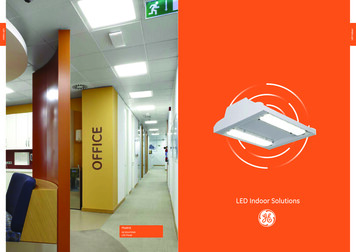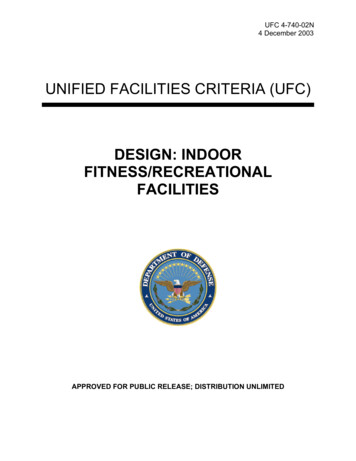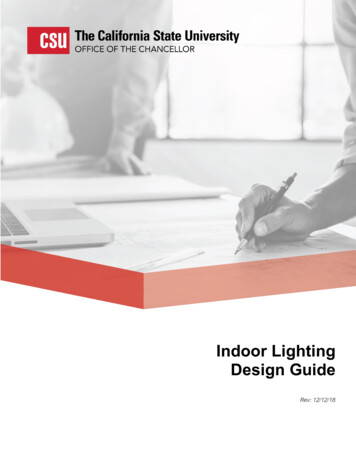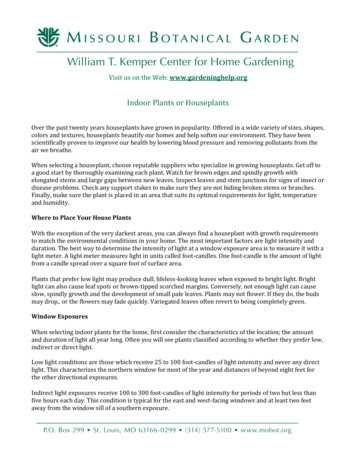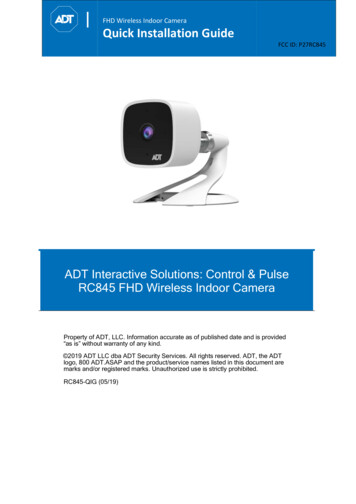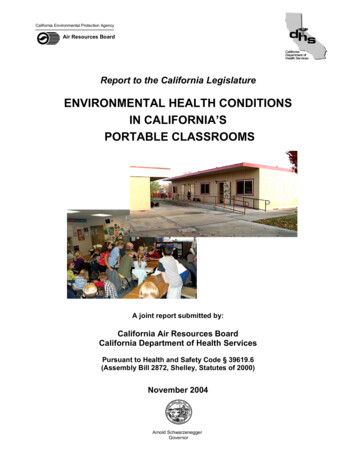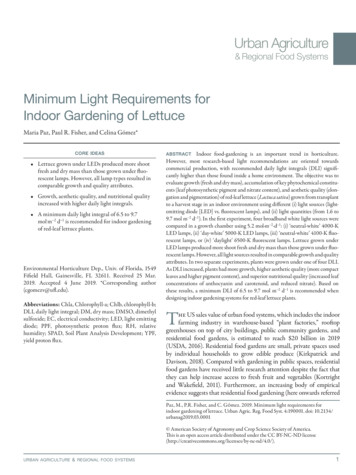
Transcription
& Regional Food SystemsMinimum Light Requirements forIndoor Gardening of LettuceMaria Paz, Paul R. Fisher, and Celina Gómez*core ideas L ettuce grown under LEDs produced more shootfresh and dry mass than those grown under fluorescent lamps. However, all lamp types resulted incomparable growth and quality attributes. G rowth, aesthetic quality, and nutritional qualityincreased with higher daily light integrals. A minimum daily light integral of 6.5 to 9.7mol m–2 d–1 is recommended for indoor gardeningof red-leaf lettuce plants.Environmental Horticulture Dep., Univ. of Florida, 1549Fifield Hall, Gainesville, FL 32611. Received 25 Mar.2019. Accepted 4 June 2019. *Corresponding author(cgomezv@ufl.edu).Abbreviations: Chla, Chlorophyll-a; Chlb, chlorophyll-b;DLI, daily light integral; DM, dry mass; DMSO, dimethylsulfoxide; EC, electrical conductivity; LED, light emittingdiode; PPF, photosynthetic proton flux; RH, relativehumidity; SPAD, Soil Plant Analysis Development; YPF,yield proton flux.Indoor food-gardening is an important trend in horticulture.However, most research-based light recommendations are oriented towardscommercial production, with recommended daily light integrals (DLI) significantly higher than those found inside a home environment. The objective was toevaluate growth (fresh and dry mass), accumulation of key phytochemical constituents (leaf photosynthetic pigment and nitrate content), and aesthetic quality (elongation and pigmentation) of red-leaf lettuce (Lactuca sativa) grown from transplantto a harvest stage in an indoor environment using different (i) light sources (lightemitting diode [LED] vs. fluorescent lamps), and (ii) light quantities (from 1.6 to9.7 mol m–2 d–1). In the first experiment, four broadband white light sources werecompared in a growth chamber using 5.2 mol m–2 d–1: (i) ‘neutral-white’ 4000-KLED lamps, (ii) ‘day-white’ 5000-K LED lamps, (iii) ‘neutral-white’ 4100-K fluorescent lamps, or (iv) ‘daylight’ 6500-K fluorescent lamps. Lettuce grown underLED lamps produced more shoot fresh and dry mass than those grown under fluorescent lamps. However, all light sources resulted in comparable growth and qualityattributes. In two separate experiments, plants were grown under one of four DLI.As DLI increased, plants had more growth, higher aesthetic quality (more compactleaves and higher pigment content), and superior nutritional quality (increased leafconcentrations of anthocyanin and carotenoid, and reduced nitrate). Based onthese results, a minimum DLI of 6.5 to 9.7 mol m–2 d–1 is recommended whendesigning indoor gardening systems for red-leaf lettuce plants.abstractThe US sales value of urban food systems, which includes the indoorfarming industry in warehouse-based “plant factories,” rooftopgreenhouses on top of city buildings, public community gardens, andresidential food gardens, is estimated to reach 20 billion in 2019(USDA, 2016). Residential food gardens are small, private spaces usedby individual households to grow edible produce (Kirkpatrick andDavison, 2018). Compared with gardening in public spaces, residentialfood gardens have received little research attention despite the fact thatthey can help increase access to fresh fruit and vegetables (Kortrightand Wakefield, 2011). Furthermore, an increasing body of empiricalevidence suggests that residential food gardening (here onwards referredPaz, M., P.R. Fisher, and C. GÓmez. 2019. Minimum light requirements forindoor gardening of lettuce. Urban Agric. Reg. Food Syst. 4:190001. doi: 10.2134/urbanag2019.03.0001 American Society of Agronomy and Crop Science Society of America.This is an open access article distributed under the CC BY-NC-ND nd/4.0/).urban agriculture & regional food systems1
to as “gardening”) may provide health and well-being benefitsthrough physical activity, healthier diet, and mental acuity(Kortright and Wakefield, 2011; Nicklett et al., 2014).Consumer interest in gardening is an important urbantrend, and a growing market for companies supplying plantproducts. In 2014, one in three US households participatedin some type of gardening activity and had a total spendingbudget of 3.5 billion (NGA, 2014). Sales of vegetable beddingplants from the top 15 floriculture states in the nation increasedfrom 47 to 55 million units from 2011 to 2014, and the wholesale value of the industry increased from 75 to 99 million(USDA, 2012, 2015). Until recently, gardening was primarilyan outdoor activity, heavily dependent on climatic seasons andvulnerable to unpredictable weather, weed pressure, animals,insects, and diseases. However, limited space, soil, and waterin urban settings are bringing attention to indoor gardening,which was recently ranked as the fastest-growing trend inhorticulture by an industry group (GMG, 2017).As part of the gardening experience, consumers typicallypurchase vegetable bedding plants at a transplant or preharvest stage to grow on to harvest. Nonetheless, information onconditions required to successfully finish vegetable beddingplants is lacking to support consumers interested in indoorgardening. For example, although numerous studies haveevaluated growth and development of lettuce under differentlight qualities and quantities in controlled environments(Chen et al., 2016; Dougher and Bugbee, 2001; Johkan etal., 2010; Kim et al., 2004; Li and Kubota, 2009; Lin et al.,2013; Son and Oh, 2013), most research-based recommendations for indoor plant production typically aim to maximizeyield under optimal environmental conditions. In contrast,research to support non-commercial, small-scale indoorgardening should seek to identify environmental set pointsthat can satisfy human comfort and function, and can ensurea successful harvest without compromising aesthetic andnutritional quality. This is because consumers are not likely tochange the environmental set points within their home environment to maximize plant yield at the expense of comfort.To our knowledge, no published studies have evaluatedgrowth and quality of lettuce grown under DLI that are significantly below the typical recommended ranges for commercialproduction. Nonetheless, light quantity used for commerciallettuce production is considerably higher than the typical DLIwithin a residential environment. Both et al. (1997) recommended 17 mol m–2 d–1 to produce a 150-g lettuce head. Similarly,Fu et al. (2012) measured the highest lettuce yield (158 to 163 g)with 20 to 30 mol m–2 d–1. Recommended light intensities forhuman comfort in a residential indoor environment are 7 µmolm–2 s–1, if using cool-white fluorescent lamps (adapted from U.S.General Services Administration, 2013). At that light intensity,lamps would only provide 0.6 mol m–2 d–1 if operated for 24 h.Therefore, supplementing light within a residential indoor environment is necessary to sufficiently support indoor gardening.Rapid advancements of light-emitting diode (LED) lampshave made it possible to evaluate various aspects of plant growthand development indoors. To date, most studies using LED lampsfor lettuce production have compared a combination of red (600to 700 nm) and blue (400 to 500 nm) light (Johkan et al., 2010;Li and Kubota, 2009; Liu et al., 2016; Son and Oh, 2013; Stutteet al., 2009), with some studies evaluating the addition of far-redor broadband white light (Kubota et al., 2011; Lin et al., 2013;Park and Runkle, 2018). Stutte et al. (2009) found that lettucegrown with 19 mol m–2 d–1 under red or red and blue LEDlamps produced approximately 30% more biomass than plantsgrown under the same DLI using fluorescent lamps. However,plants grown under red and blue LED lamps appear purplish grayto the human eye and are not aesthetically pleasing. In addition,broadband white lamps are more readily available as off-the-shelfproducts for consumers interested in indoor gardening.The objective of this study was to evaluate growth, accumulation of key phytochemical constituents, and aestheticquality of red-leaf lettuce grown from the transplant-to-harveststage indoors using different (i) light sources (LED vs. fluorescent lamps), or (ii) light quantities (from 1.6 to 6.5 mol m–2d–1 or from 2.5 to 9.7 mol m–2 d–1). Our goal was to comparelamps that were readily available for indoor gardening, ratherthan horticultural-grade lamps. Therefore, the light intensitiesevaluated in our study were below the recommended rangesfor commercial production, considering that the feasible lightintensity within a residential indoor environment would belimited by the number of fixtures within a small area, as well asthe output limitations when using off-the-shelf lamps that arereadily available for consumers. The tested cultivar, Red SaladBowl, was selected because it is a pick-and-eat variety, ratherthan a head-lettuce type, that allows multiple partial harvestsand has high aesthetic quality for salad use. We hypothesizedthat growth and quality of plants would be similar underthe different broadband white lamps, and that increasingDLI would increase biomass production and quality attributes. We further hypothesized that a DLI 10 mol m–2 d–1would satisfy consumer requirements for indoor gardening,which we defined as achieving active growth at the end of theexperiment, and with a lack of etiolated growth (measured bychlorophyll and anthocyanin content and leaf elongation).MATERIALS AND METHODSLight Quality ExperimentIn Experiment 1, seeds of ‘Red Salad Bowl’ (Johnny’sSelected Seeds, Fairfield, ME) lettuce, which require 50 daysto maturity, were germinated in a 102-cell tray filled withhorticultural grade substrate composed of 7 to 10% (v/v)perlite, 70 to 65% peat moss, and 23 to 25% coir (Pro-Mix MPMycorrhizae Organik, Premier Tech Horticulture, Quakertown, PA) and topped with coarse vermiculite. Plants werepropagated for one week in a germination room at a constanttemperature of 23 C and 80% relative humidity (RH), with2urban agriculture & regional food systems
fluorescent light providing a DLI of 5.7 mol m–2d–1 (100 µmolm–2 s–1 for 16 h d–1). One week after sowing, trays were movedto an even-span glass-glazed greenhouse located at the University of Florida in Gainesville, FL (30 N. lat). Four weeks aftersowing, five uniform seedlings with four true leaves were transplanted into 16-cm diameter, 6-cm tall containers filled with700 mL of an Irish Sphagnum peat substrate with no fertilizer charge (Bulrush Horticulture LTD, Magherafelt, UK),amended with 30% coarse perlite by volume, and 5.5 kg m–3(0.4 g L–1 N) of 8–1.75–3.32 N–P–K (Sustane 8-4-4, SustaneNatural Fertilizer, Inc., Cannon Falls, MN). The day, night,and average air temperatures during that period were 24.3 2.2 C, 20.7 1.2 C, and 22.5 2.9 C, respectively, and theaverage DLI was 17 4.3 mol m–2 d–1. The initial productionphase ended 5 wk after sowing, when transplants were considered a prefinished vegetable bedding plant product suitablefor sale to indoor gardeners (with 6 to 8 fully extended leaves).At that point, containers were moved to a growth chamber tocompare growth under different light sources.The walk-in growth chamber (C6 Control System withECoSys Software, EGC, Chagrin Falls, OH) was equippedwith four shelving units (1.8-m tall, 0.9-m wide, and 0.6-mdeep), each with four shelves. Each shelving unit was considered a block, providing a total of four blocks. The four replicateshelves (0.4-m tall, 0.6-m wide, 0.6-m deep) had a randomlyassigned light treatment replication within each shelving unitresulting in a randomized complete block design. Each shelfwas surrounded with white plastic with black backing, toprevent light pollution, and had a 2.5-cm thick foam boardat the bottom to provide heat insulation. Four containers,each with five plants, were placed on each replicate shelf. Fouroff-the-shelf broadband white light sources were compared astreatments: (i) ‘neutral-white’ 4000-K LED lamps (4000LED[Model 97743, Green Creative, San Bruno, CA]), (ii) ‘daywhite’ 5000-K LED lamps (5000LED [Model 40803, GreenCreative]), (iii) ‘neutral-white’ 4100-K fluorescent lamps(4100FLR [Model 64234, GE Lighting, Cleveland, OH]),or (iv) ‘daylight’ 6500-K fluorescent lamps (6500FLR [Model64243, GE Lighting]). All lamps were retrofitted to a 0.6-mlong T8 strip light (Metalux SNF217R, Cooper Lighting,Peachtree City, GA). The spectral distribution of each lightsource was measured with a spectroradiometer (SS-110,Fig. 1. Normalized spectral power distribution of 4000-K(4000LED) or 5000-K (5000LED) light-emitting diode (LED)lamps (A), and 4100-K (4100FLR) or 6500-K (6500FLR)fluorescent lamps (B). Photon flux (µmol m –2 s –1) was measuredfor every 1 nm.Apogee Instruments Inc., Logan, UT) and is shown in Figure1 and described in Table 1.Prior to starting the experiment, a quantum sensor(LI-COR LI-250A, LI-COR, Lincoln, NE) was used tomeasure photosynthetic photon flux (PPF) to ensure thatplants received an average of DLI of 5.2 mol m–2 d–1 (120 µmolm–2 s–1 for 12 h d–1 from 0600 to 1800 h). The set point forambient CO2 and RH were 400 ppm and 70%, respectively.Temperature was set at 22 C, which is a common temperature set point within residential environments. The recordedair temperature (day/night) during the experiment was 24.7 1.6 C/22.2 1.4 C , measured with a temperature logger(WatchDog A Series, Spectrum Technologies, Aurora, IL)placed at the center of each compartment. Plants were wateredevery other day with 150 mL tap water. Tap water had an electrical conductivity (EC) of 0.4 mS cm–1, pH of 8.3, and 40 mgL–1 Ca–CO3 alkalinity.Table 1. Photosynthetic photon flux (PPF), total photon flux per broadband waveband, and yield photon flux (YPF) provided by different lighting RPPF(400-700 nm)120 2120 2120 1120 1Ultraviolet(340-400 nm)0.30.50.20.3Blue(400-500 nm)Green(500-600 nm)Red(600-700 nm)Far-red(700-800 nm)YPF‡25 (21%)§32 (27%)28 (23%)43 (36%)µmol m –2 s –155 (46%)55 (46%)51 (43%)51 (42%)40 (33%)34 (27%)42 (34%)26 (22%)3241105103107102† 4000-K light-emitting diode (LED) lamps (4000LED), 5000-K LED lamps (5000LED), 4100-K fluorescent lamps (4100FLR), or 6500-K fluorescent lamps (6500FLR).‡ YPF is the product of PPF and relative quantum efficiency calculated based on McCree (1971) and Sager et al. (1988).§ Numbers in parenthesis represent the percentage of each waveband from total PPF.paz et al.3
Data CollectedTwo weeks after the light treatments started (7 wk aftersowing), the temperature of the fourth true leaf was measuredfor the middle plant in each container using a hand-heldinfrared thermometer (Model IRT4, Mannix Testing andMeasurement, Lynbrook, NY). Chlorophyll content (SoilPlant Analysis Development [SPAD] index) was measuredwith a chlorophyll meter (SPAD-502, Konica Minolta SensingInc., Osaka, Japan) in all plants on the first lobe of the fourthtrue leaf, and the average SPAD index per container wasrecorded. Length of the middle rib of the fourth true leaf ofthe middle plant within each container was measured. Foreach treatment replication (shelf), two containers with fiveplants each were harvested by cutting the shoots at substratelevel. After measuring fresh mass per container, tissue wasoven-dried to a constant mass at 80 C for 72 h for dry massdetermination. Samples for dry mass per container wereground, and used to determine nitrate content. Plants withinthe remaining two containers per shelf were used to quantifycontent of key phytochemicals from fresh tissue.Chlorophyll and carotenoids were measured followingthe dimethyl sulfoxide (DMSO) extraction method describedin Richardson et al. (2002). Glass vials were wrapped inaluminum foil to protect samples from light exposure. Thevials contained 7 mL DMSO and were preheated in a 65 C water bath. A 3.1 cm2 disk was cut for the middle plantwithin each container and placed in the vial and extractedfor 30 min in the dark. Samples were removed from the waterbath, the extracted liquid was brought to a volume of 10 mLwith DMSO, and 2.5 mL of each extract were transferred toa disposable polystyrene cuvette. Pure DMSO was used asthe blank. The absorbance of both blank and samples weremeasured with a spectrophotometer (SpectraMax Plus 384,Molecular Devices, Sunnyvale, CA) at 480, 649, and 665 nm.Chlorophyll-a (Chla), chlorophyll-b (Chlb), and carotenoidswere calculated using the equations from Wellburn (1994).Anthocyanins were measured using the methanol extractionmethod described in Gould et al. (2000). A 10-mm diameter diskwas cut as a sample from the distal half of each leaf lamina. Thesamples were agitated gently in the dark for 24 h at 4 C in 1 mLof 3 M HCl, water, and methanol (1:3:16 by volume). Sampleswere then placed in a centrifuge for 15 min. The absorbance ofthe extracts were measured with a spectrophotometer at 530(A530) and 653 (A653) nm, with methanol used as the blanksolution. Anthocyanin concentration was calculated as A530–(0.24 A653). Nitrate was analyzed using the methods describedin Cataldo et al. (1975) and Lin et al. (2013). Standard solutionswere made containing approximately 60 µg of nitrate nitrogen(NO3–N). Dried samples were ground to a 35-mesh size and 100mg were suspended in 10 mL of deionized water. The suspensionwas incubated at 45 C for 1 h. Samples were then mixed, placedin the centrifuge at 5000 gn for 15 min, and 0.2 mL of the extractswere pipetted into a 50 mL Erlenmeyer flask. The samples weremixed with 0.8 mL of 5% (w/v) salicylic acid in concentrated,pure sulfuric acid. After 20 min at room temperature, 19 mL of2M NaOH were slowly added to the samples, then left to cool(for 30 min) to room temperature before being transferred tocuvettes. Absorbance was measured with a spectrophotometer at410 nm. The blank was 0.2 mL of water in the reagents.The experiment was replicated a second time, following thesame procedures with the exception that seedlings were transplanted into the containers 1 wk earlier (i.e., 3 wk after sowing),treatments began 4 wk after sowing, and plants were harvested2 wk later (i.e., 6 wk after sowing). Day, night, and average airtemperature while plants were grown in the greenhouse (2 to4 wk after sowing) averaged 22.5 0.8 C, 21.3 0.2 C, and21.9 0.5 C, and the average DLI was 7.6 3.8 mol m–2 d–1.The air temperature (day/night) recorded in the growth chamberduring the second experimental run was 23.6 1.4 C/22.0 0.8 C. Data from both replications were analyzed in a combinedanalysis using analysis of variance (ANOVA) as a randomizedcomplete block design using SAS PROC GLIMMIX (SASInstitute, 2012). Random effects for the model were experimental replication and its interaction with block. Treatmentmeans were separated using Tukey’s test at P 0.05.Light Quantity ExperimentsIn Experiment 2, lettuce seeds were propagated and transplanted following the same procedures as previously described,with the exception that due to excessive ambient temperature inthe greenhouse ( 27 C), plants were propagated, transplanted,and grown in a growth room for 4 wk without a greenhousephase. Set points for DLI and air temperature (day/night)during that period were 6.9 mol m–2 d–1 (120 µmol m–2 s–1 for16 h d–1) and 23 C/22 C, respectively. Five weeks after sowing,containers with five plants were transferred into a walk-ingrowth chamber and experimental treatments were initiated.The growth chamber had the same setup as previously described,with four blocks (shelving units), each with four replicate shelvesthat differed in light treatment. Based on findings from Experiment 1, 4000LED lamps were used to provide the following DLItreatments: 1.6, 2.2, 3.7, or 6.5 mol m–2 d–1 (37, 52, 85, or 150µmol m–2 s–1 for 12 h d–1 from 0600 to 1800h). Target PPF wasachieved by adjusting the number of lamps per fixture. The setpoint for ambient CO2 and RH were 400 ppm and 70%, respectively. Ambient temperature was set at 22 C, and the recordedair temperature (day/night) during the experiment was 22.8 1.9/21.6 1.0 C. In order to avoid a confounding effect ofsubstrate moisture level on light level, plants were irrigated with150 mL tap water every time their container weighed less than350 g (approx. average weight at which containers were at 50%container capacity). Plants in containers under 1.6, 2.2, 3.7, and6.5 mol m–2 d–1 received 450, 750, 1050 and 1500 mL of water,respectively. The experiment was terminated 9 wk after sowing(i.e., 4 wk of treatment). Data collected included: leaf temperature, SPAD index, leaf length, shoot fresh and dry mass, andconcentrations of Chla, Chlb, carotenoids, anthocyanins, andnitrate, following the same protocols as previously described.4urban agriculture & regional food systems
Table 2. Effect of light source on growth, leaf temperature, and quality attributes of ‘Red Salad Bowl’ grown for two weeks underdifferent lighting 4100FLR6500FLRmm182 a§174 a180 a172 aFreshmassDrymassLeaftemperature3.7 a3.6 a3.1 b3.0 b C21.7 ab21.5 b22.8 a21.8 abg59 a56 a51 b49 bSPADindex28 a29 a27 a28 aChl a‡1.02 a1.13 a1.15 a1.16 aChl b‡Carotenoids0.42 a0.45 a0.47 a0.47 aµg/g FM0.26 a0.27 a0.27 a0.27 aAnthocyaninNitrate0.53 a0.62 a0.65 a0.51 aµg/g DM34.91 a28.73 a32.90 a32.70 a† 4000-K light-emitting diode (LED) lamps (4000LED), 5000-K LED lamps (5000LED), 4100-K fluorescent lamps (4100FLR), or 6500-K fluorescent lamps (6500FLR).‡ FM, fresh mass; DM, dry mass; Chla, chlorophyll-a; Chlb, chlorophyll-b.§ Mean within columns with different letters are significantly different by Tukey’s HSD test at P 0.05.A follow-up experiment (Experiment 3) was conducted,which eliminated the lowest DLI from the previous experiment, and included a higher DLI of 9.7 mol m–2 d–1 to comparea broader range of DLIs. Lettuce seeds were propagated underthe same conditions described for Experiment 2, with theexception that seedlings were transferred to a greenhouse 1 wkafter sowing. Three weeks after sowing, three seedlings weretransplanted to 15.2-cm in diameter, 9.5-cm tall containersfilled with Irish Sphagnum peat amended with 30% coarseperlite (by volume) and 5.5 kg m–3 of 8–1.75–3.32 N–P–KContainers were immediately moved inside two walk-ingrowth chambers. The day, night, and average air temperaturein the greenhouse for that period (1 to 3 wk after sowing) was22.3 0.6 C, 21.3 0.2 C, and 21.8 0.4 C, respectively,and average DLI was 7.8 3.7 mol m–2 d–1.In Experiment 3, commercial horticultural-grade LEDmodules (GreenPower, Philips Lighting, Somerset, NJ; 150-cmlong) were used to provide the following DLI treatments: 2.2, 3.7,6.5, or 9.7 mol m–2 d–1 (52, 85, 150, or 225 µmol m–2 s–1 for 12 hd–1 from 0600 to 1800 h). The experiment was conducted in twogrowth chambers, each with two shelving units (1.8-m tall, 1.8-mwide, and 0.6-m deep). Each shelving unit had four shelves (individual replicates, 0.4-m tall, 1.4-m wide, and 0.6-m deep), andeach shelf had one of four randomly assigned DLI. The broadband LED modules had peak wavelengths of 660 and 450 nm andprovided 12% blue, 18% green (500–600 nm), and 70% red light(measured with a spectroradiometer). Target PPF was achievedby varying the number of energized lamps within a compartment. The set point for ambient CO2 and RH were 400 ppm and70%, respectively. Ambient temperature was set at 22 C, andthe recorded air temperature (day/night) during the experimentwas 24.7 1.2 C/21.7 0.8 C, measured with a temperaturelogger. Plants were irrigated with 280 mL tap water every timetheir container weighed less than 380 g (approx. average weightat which containers were at 50% container capacity). Plants incontainers under 2.2, 3.7, 6.5, and 9.7 mol m–2 d–1 received 1040,1040, 1320, and 1880 mL of water, respectively. The experimentwas terminated 7 wk after sowing (i.e., 4 wk of treatment), anddata collected were the same as previously described.Because of differences in DLI and other details betweenExperiments 2 and 3, regression analysis was performed byexperiment on data for leaf temperature, SPAD index, leafpaz et al.length, and shoot fresh and dry mass using SAS. Data forchlorophyll, carotenoid, anthocyanin, and nitrate contentwere analyzed by experiment with ANOVA as a randomizedcomplete block design using SAS PROC GLIMMIX (SASInstitute, 2012). Random effects for the model in Experiment2 were experimental replication and its interaction with block.Random effects for the model in Experiment 3 were growthchamber and its interaction with block. Treatment meanswere separated using Tukey’s test at P 0.05.RESULTS AND DISCUSSIONExperiment 1Light quality from the different lamps had no significanteffect on leaf length, SPAD index, Chla and Chlb, carotenoids,anthocyanin, and nitrate content (Table 2). However, shootfresh and dry mass were up to 20 and 23% higher in plantsgrown under LED compared with those grown under fluorescent lamps, which corresponds with the findings of others (Linet al., 2013; Son and Oh, 2013; Stutte et al., 2009). Severalstudies have evaluated the effect of spectral quality on lettucegrowth. Although Snowden et al. (2016) suggested that lettuceis highly sensitive to light intensity, but minimally sensitive tospectral quality, others have reported higher biomass accumulation under red or far-red enriched light (Chen et al., 2016;Mickens et al., 2018; Son and Oh, 2013; Wang et al., 2016).Similarly, green-light supplementation has been shown toenhance lettuce growth under sole-source lighting (Kim et al.,2004; Mickens et al., 2018). In our study, plants grown under4000LED and 4100FLR were exposed to the highest percentages of red and far-red light (Table 1). However, both LEDlamps emitted more green light than fluorescent lamps, whichhas been shown to penetrate deeper into leaves, resulting inhigher CO2 fixation of inner chloroplasts and thus, higheroverall leaf photosynthesis compared to red or blue light (Sunet al., 1998; Terashima et al., 2009). Green light has also beenshown to penetrate deeper into the foliar canopy when appliedwith other wavebands, and can therefore increase whole-plantphotosynthesis by stimulating CO2 fixation of inner- andlower-leaves when foliar canopies close (Frantz et al., 2000;Kim et al., 2004). We grew five plants in each container, whichcould have induced premature canopy closure. Canopy closure5
Fig. 2. Morphology of ‘Red Salad Bowl’ lettuce at harvest after exposure to 4 wk of different daily light integral (DLI) treatmentsprovided by 4000-K light-emitting diode (LED) lamps (Expt. 2) or GreenPower LED production modules (Expt. 3).coupled with the absorption of green photons by lower leavesmight have increased the photosynthetic capacity of innerleaves,and thus, potentially increased biomass productionunder higher green light. Therefore, the higher percentage ofgreen light emitted by both LED lamps may partially explainthe highest fresh and dry mass accumulation of plants grownunder LED compared with fluorescent lamps.The LED lamps used in our study also emitted slightlyhigher ultraviolet radiation compared with the two fluorescent lamps (Table 1). Ultraviolet radiation has been shown toreduce plant biomass accumulation in lettuce, most likely asa response to the high metabolic cost of accumulating photoprotective compounds such as anthocyanins, which tend toincrease in response to high energy radiation (Tsormpatsidiset al., 2008). Anthocyanins, which are responsible for the redpigmentation in red-leaf lettuce cultivars, have been suggestedto offer an array of health-promoting benefits to consumersand are therefore considered to be a desirable qualitative trait inlettuce (Gazula et al., 2007; Owen and Lopez, 2015). However,the lack of differences in anthocyanin content measured inour study suggest that fresh and dry mass accumulation werenot likely affected by low percentages of ultraviolet radiationlevels in this experiment (Table 2). Furthermore, the lack oftreatment differences for phytochemical constituents wasunexpected, as plants grown under 65000FLR were exposedto 10% more blue light compared to those grown under othertreatments. Several studies have shown a positive correlationbetween blue light and anthocyanin and carotenoid contentin lettuce leaves (Johkan et al., 2010; Li and Kubota, 2009;Owen and Lopez, 2015; Stutte et al., 2009; Tsormpatsidis etal., 2008). However, most of these studies have used monochromatic light applied as treatments. In contrast, all four ofthe treatments in our study provided broadband white light,which may have saturated the light-quality response of phytochemicals in leaves. Furthermore, potential specific wavebandinteractions within each light source may explain the lack oftreatment differences in the concentration of anthocyanins,carotenoids, and Chla and Chlb measured in our study.Yield photon flux (YPF), which weighs photons in therange from 360 to 760 nm according to plant photosyntheticresponses, was highest under 4100FLR (Table 1) (McCree, 1971;Sager et al., 1988). In addition, leaves of plants grown under4100FLR were 1 C warmer than those grown under othertreatments (Table 2). Warmer leaves may be indicative of partialstomatal closure (Blonquist et al., 2009), which reduces transpiration and photosynthesis and may explain the lower growthunder 4100FLR compared with the two LED treatments,even though YPF was highest under 4100FLR. Moreover, thehighest percentage of blue light in 6500FLR might explain thegrowth reduction measured in plants grown under this treatment. Because approximately 20% of blue photons are absorbedby inactive pigments, their energy is not efficiently transferredto reaction centers, significantly reducing the quantum yield ofabsorbed blue photons (Barnes and Bugbee, 1992). The lowerquantum yield is most likely responsible for the lowest fresh anddry mass accumulated under 6500FLR.Experiments 2 and 3For both experime
urban agriculture & regional food systems 1 & r f s Minimum Light Requirements for . Indoor Gardening of Lettuce. Maria Paz, Paul R. Fisher, and Celina Gómez* abstract. Ind


